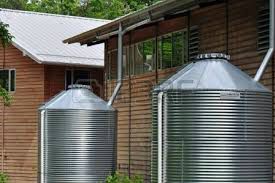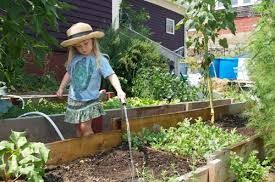Downspout Water Collection
Our roofs are natural rain water collectors. Whether we live in a house, a townhouse or condominium, chances are that we have at least one downspout that we can set up to access rain water, either now or else later, when the earthquakes and/or lack of electricity have ended our current water supplies.
This water will need to be purified before it is drunk or used for cooking or bathing -- remember that the skin absorbs water easily, so it will also absorb any pathogens!
However, rainwater can be used (as is) for watering our gardens and orchards. We can also boil it for washing dishes or clothes, as well as for bathing. And we can filter it and boil it for drinking purposes.
The downspout pours its water into a large water barrel. Make sure that the water barrel is covered, or you may find a drowned squirrel in your water, as I once did!
Here is a plastic water barrel (try to get BP-free plastic) with a stainless steel mesh over its opening:
You can attach an overflow hose high up on the barrel side and let the extra water go out to a tree or vegetable bed, or you can connect the overflow hose into another barrel. In this way, you can have many water barrels lined up in a row, which allows you to store more water during the rainy times.
Each barrel should have a lid that comes off easily for cleaning, and also a spout near the bottom of the barrel. If you can, raise your barrels at least 10 inches from the ground so that you can easily collect the water from the spout, or else put the spout up about 8 inches from the bottom of the barrel. Or, even better, you can attach a hose so that you can collect water without stooping.
Do a Google Images search to see various examples, and then go to your favourite hardware store and see what they have available. Shop online too.
Of course, a filter at your eavestrough would save you and your back from cleaning out the water barrels too often:
How fancy can your rain water collection system get? Here are two pretty sophisticated set ups:
Notice the slight downhill slope to the barrels in the photo above. This allows for each overflow pipe to easily fill the next barrel. They are also in a shady spot and under an overhanging roof so that the sun or a snowfall cannot damage the plastic.
Water will not always be as easy to get as it is now, so setting yourself up for some rain water collection may be the smartest thing that you do!
Water is the #1 Priority
The blue rain barrel in the background is providing the irrigation for this garden.
These barrels can also be used to collect grey (used) water from the house via a pipe, and then you can water your garden with the grey water.
Using this household water in your garden conserves water, but it also requires that only bio-degradable products be used in the house (soaps, shampoos, etc).
Country & Cottage Water Systems
by Max Burns
Table of Contents
Chapter 1: Introduction to on-site water and sewage systems
Chapter 2: Sources of water
Chapter 3: Pumps: The how and why (and where and when) of water-moving devices
Chapter 4: Hooking up the system
Chapter 5: Checking your water quality
Without water, we will die. This book explains everything from step one. It is a MUST HAVE.
Chapter 6: Purifying the water
Chapter 7: Dealing with septic systems
Chapter 8: Stand-alone toilets
Chapter 9: The humble outhouse
Chapter 10: Grey water
Chapter 11: Getting water in winter
Chapter 12: Closing up and opening up: Rituals for a seasonally adjusted water source

